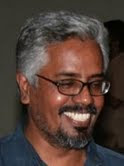sajith paintings
Mapping The Neural Networks of Civilisation -
On the Paintings by A.S. Sajith
C S Venkiteswaran
The Terrain Named Diamond White -
According to Sajith what he is attempting to do in this series of paintings and drawings titled The Terrain Named Diamond White is "to observe body through a different faculty which is "neural" in nature. Sense organs furnish only the external in body. We approach the internals through the faculty of consciousness, which is lauded as a thing capable of seeking itself. We think that we think therefore we are." And he places himself outside the usual binaries that we are fond of and seek refuge in. For he is not "a romantic who believes that human being is miniscule before infinity. The capability of human to destroy and construct, to bring about dramatic changes to the environment are rendered in the Terrain series . The paintings unfold repetition, growth and transformation rather than a clear cut preplanned visual."
If his earlier show 'Kari' tried to sketch these intensely and overwhelmingly multiplying details in charcoal, here he breaks out in colour. In these canvases you encounter sights that one could describe as 'out of the body', as they look at our life-world, life and civilization from a perspective or angle that one could term aerial, one that reveals us in our fatal contexts – physical, natural as well as civilisational. Sajith's paintings thus attempt to map the neural layout of perception as well as human condition.

These canvases are an invitation to a maze; they invite you into an engrossing yet dispassionate journey, full of enigmatic encounters and discoveries, and traverse extremes - the most miniscule and the gross, the organic and the inorganic, natural and man-made. While the organic realm teem with flora and fauna – miniscule and proliferating – the other, the man-made yet impersonal realm is busy engrossed in their seemingly repetitive activities and motions. These oneiric images drenched in dull yet luminous hues, are populated by monocultural forests, both of vegetation and urban habitat. Sometimes you find upright phallic structures and formations – a mount, a flag pole - rising up against the teeming and pullulating mass that envelops it. Other times, the growing mass is ruptured by chasms and openings that gape into the void. One encounters such stillness and silence in the middle of the tumultuous animation, like stark and silent reminders of the dark potentials of life and civilization, as it were. Like hope or despair, they persist against the abundance of presence around it, as if mediating between life and death, organic and inorganic. On the other, you also have the crystalline lilac mount rising up from the fluid oceanic vastness that surges around it, a huge yak-like figure submerged in water, its hump and horns sticking out, and a bluish forest of entwining branches with snake-like proliferation below it. All his images place the explosive presence of life and living against the ominous presences of its other.
These paintings encounter us with visions that are somehow freed from our everyday corporeal selves and its perspectival bounds. Accompanying it is a certain sensation of extreme involvement and also non-attachment, a willful duplicity that privileges us with disturbing yet clinical insights into our-selves.
The all-pervasive desolation that arises out of perspective offered by these paintings reminds us of the baffling complexity and boundedness of our life-world – both of body and consciousness, the most subtle and the atomic, the gross and the big. Thus these images follow and map the neural networks of our civilization, one that is simultaneously inside and outside.
On the Exhibition of Paintings by A.S. Sajith at Lalit Kala Akademy Hall, Vailoppilli Sanskriti Bhavan, Thiruvananthapuram in January 2009







 still from Raamanam
still from Raamanam
 A Still from Njatadi
A Still from Njatadi








